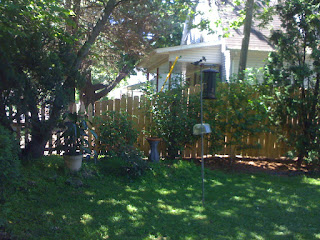Wood, metal and vinyl are common materials for fences. Wood used for fences should be resistant to rot; chemical treated pine and cedar (naturally resistant to rot) are the most common choices. Cedar is the more expensive option of the two, but it is a better choice for the environment and human health. In addition, I think most people would agree that cedar makes a more beautiful fence.
Wood fences are the most versatile. While they can be purchased in pre-constructed panels, lumber yards also carry a variety of fence pickets that can be used to construct custom site built fences. Custom fences can blend in better with your landscape by fitting into the contours of your yard and provide flexibility in locating gates and transitions.

Wood fences can be left natural or stained or painted. If stained or painted, they require periodic maintenance. Metal and vinyl fences are purchased in pre-made panels and are pre-finished. The finish on these fences will require less periodic maintenance than a finished wood fence. Indeed, the finish on a vinyl fence should last for a long time but it is not re-paintable.
Whatever material you choose, you will want to consider how much open space to leave between the fencing units, and how you want to orient them. These decisions will not only effect light and views that the fence allows to pass through. Fences also reduce noise infiltration and can block wind and create a microclimate inside your yard.
With wood fences, moisture is an important issue to consider. While your fence should be designed to shed water it should also have adequate ability to to dry out once it gets wet. Pickets that are right up next to each other will dry out more slowly than ones with a space in between.
You don't have to choose just one style of fence picket, spacing, or height however. In fact, carefully designed transitions can add to the beauty and functionality of your fence.
Before you commit to final decisions about fence height and spacing, you need to check with the city. You will need a permit to build the fence ($25 in Urbana last time I got one) and they may have opinions about how your fence is built especially if driving visibility is potentially an issue. They will likely require a maximum 4ft high fence with 50 percent open space next to your neighbor's driveway or the street corner.
You also need to consider the material and method of installation of the fence posts. Although they are not necessarily the showpiece of the fence, the posts are possibly the most essential part of the design. They are likely, if well installed, to outlive the original fence and live on the support its replacement.
Fence posts can be metal or wood. With a vinyl fence, wood posts are covered with a vinyl veneer.
Even if you choose to use cedar for the fence framing and pickets, I recommend chemical treated wood for the posts since they are in direct contact with the ground.
Posts need to be set at least 30 inches deep because 30 inches in the maximum frost line in our area. I prefer to dig down at least 40 inches in order to be able to provide 5 inches of gravel (to drain water away from the bottom of the post) and still have the bottom of the post well below the frost line.
The reason for setting posts below the frost line is a phenomenon called "frost heave." The ground expands when it freezes and, since it can't go down, it raises up. If your fence's foundation is in the part of the ground that freezes and thaws, the fence will rise and fall with the seasons. This movement will eventually bring the fence down.
Another concern with frost heave is the possibility that the sides of the post and concrete footing will stick to the ground and, despite the bottom of the post being below the frost line, the freezing ground will drag the post up with it. This concern can be eliminated by using special cardboard forms made for the purpose. These forms add significantly to the cost of setting posts, and the problem can be minimized simply by taking care to dig a hole with smooth edges.
Post for fences are often set with or without concrete, with or without forms, and with wet or dry concrete. All of these options affect the amount of labor and cost involved in building the fence and have different advantages and disadvantages. Deciding what options are best for your project is crucial.
Part of your fence design should also consider a method of shedding water off the top of the posts. This can range from copper caps to simply cutting the post off at an angle.
Above, posts are cut to emulate the "dog ear" shape of the pickets.
Your fence will likely require some sort of gates. Choosing the hardware, location, and style of gates can be a lot of fun. Consider installing springs to close the gate behind you when you've got your hands are full.
Thanks for reading and feel free to call or email for a complimentary consultation and estimate on your fence project.
Also, check out this article I submitted (published Oct/Nov 2011 issue) to Fine Homebuilding about fence building:





A fence beauty depend on fence design and it's used material.I personally like vinyl fence.Thanks for sharing great information about fence.
ReplyDeleteFences Toronto
Good point, thank you!
ReplyDeletewas digging under the fence to access our yard, so we reinforced the bottom portion to prevent that. However, we found out the hard way that grey foxes can climb. As a result we decided to retrofit our fence by electrifying it. chain link fence gate
ReplyDelete